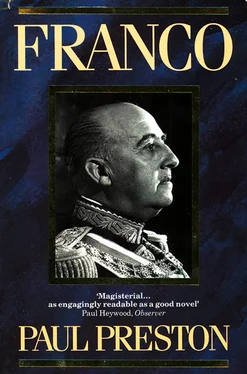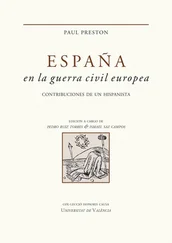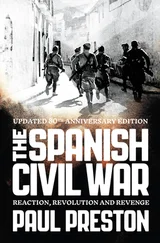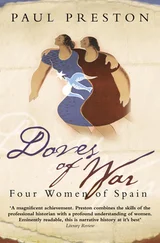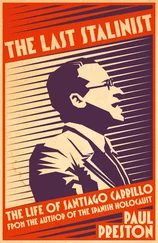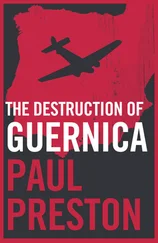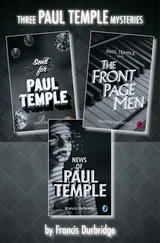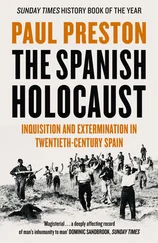Paul Preston - Franco
Здесь есть возможность читать онлайн «Paul Preston - Franco» — ознакомительный отрывок электронной книги совершенно бесплатно, а после прочтения отрывка купить полную версию. В некоторых случаях можно слушать аудио, скачать через торрент в формате fb2 и присутствует краткое содержание. Жанр: unrecognised, на английском языке. Описание произведения, (предисловие) а так же отзывы посетителей доступны на портале библиотеки ЛибКат.
- Название:Franco
- Автор:
- Жанр:
- Год:неизвестен
- ISBN:нет данных
- Рейтинг книги:5 / 5. Голосов: 1
-
Избранное:Добавить в избранное
- Отзывы:
-
Ваша оценка:
- 100
- 1
- 2
- 3
- 4
- 5
Franco: краткое содержание, описание и аннотация
Предлагаем к чтению аннотацию, описание, краткое содержание или предисловие (зависит от того, что написал сам автор книги «Franco»). Если вы не нашли необходимую информацию о книге — напишите в комментариях, мы постараемся отыскать её.
Franco — читать онлайн ознакомительный отрывок
Ниже представлен текст книги, разбитый по страницам. Система сохранения места последней прочитанной страницы, позволяет с удобством читать онлайн бесплатно книгу «Franco», без необходимости каждый раз заново искать на чём Вы остановились. Поставьте закладку, и сможете в любой момент перейти на страницу, на которой закончили чтение.
Интервал:
Закладка:
The convoy’s success was a devastating propaganda blow to the Republic. The news that the ruthless Army of Africa was on the way depressed Republican spirits as much as it boosted those in the Nationalist zone. By 6 August, there were troop-ships regularly crossing the Straits under Italian air cover. The Germans also sent six Heinkel He-51 fighters and ninety-five volunteer pilots and mechanics from the Luftwaffe. Within a week, the rebels were receiving regular supplies of ammunition and armaments from both Hitler and Mussolini. The airlift was the first such operation of its kind on such a scale and constituted a strategic innovation which redounded to the prestige of General Franco. Between July and October 1936, 868 flights were to carry nearly fourteen thousand men, 44 artillery pieces and 500 tons of equipment. 82
At this time, Mola made a significant error in the internal power stakes. On 1 August, heir to the Spanish throne, the tall and good-natured Don Juan de Borbón, the third son of Alfonso XIII, arrived in Burgos in a chauffeur-driven Bentley. * Anxious to fight on the Nationalist side, he had left his home in Cannes on 31 July, despite the fact that on that day his wife Doña María de Mercedes was giving birth to a daughter. Mola ordered the Civil Guard to ensure that he left Spain immediately. The fact that he did so abruptly and without consultation with his fellow generals revealed both Mola’s lack of subtlety and his anti-monarchist sentiments. The incident contributed to deeply monarchist officers transferring their long-term political loyalty to Franco. 83 In contrast, when Franco later took a similar step, preventing Don Juan volunteering to serve on the battleship Baleares , he was careful to pass off his action as an effort to guarantee that the heir to the throne should be ‘King of all Spaniards’ and not be compromised by having fought on one side in the war. 84
Two days after the successful ‘victory convoy’, Franco flew to Seville and established his headquarters in the magnificent palace of the Marquesa de Yanduri. 85 Marking a clear distinction with Queipo’s more modest premises, the palace’s grandeur revealed more about Franco’s political ambitions than his military necessities. He began to use a Douglas DC-2 to visit the front or travel to meet Mola for consultations. 86 In Seville, he began to gather around him the basis of a general staff. Apart from two ADCs, Pacón and an artillery Major Carlos Diaz Varela, there were Colonel Martín Moreno, General Kindelán and, a recent arrival, General Millán Astray. 87 This reflected the fact that finally he had an army on the move.
Even before the ‘victory convoy’, Franco had already, on 1 August, ordered a column under the command of the tough Lieutenant-Colonel Carlos Asensio Cabanillas to occupy Mérida and deliver seven million cartridges to the forces of General Mola. The column had set out on Sunday 2 August in trucks provided by Queipo de Llano and advanced eighty kilometres in the first two days. Facing fierce resistance from untrained and poorly armed Republican militiamen, they took another four days to reach Almendralejo in the province of Badajoz. Asensio’s column had been followed on 3 August by another column led by Major Antonio Castejón which had advanced somewhat to the east and on 7 August by a third under Lieutenant-Colonel Heli Rolando de Tella. Franco telegrammed Mola on 3 August to make it clear that the ultimate goal of these columns was Madrid. After the frenetic efforts of the previous two weeks to secure international support and get his troops across the Straits, Franco’s mood was euphoric.
Franco placed Yagüe in overall field command of the three columns. He ordered them to make a three-pronged attack on Mérida, an old Roman town near Cáceres, and an important communications centre between Seville and Portugal. The columns advanced with the Legionaires on the roads and the Moorish Regulares fanning out on either side to outflank any Republican opposition. With the advantage of local air superiority provided by Savoia-81 flown by Italian Air Force pilots and Junkers Ju-52 flown by Luftwaffe pilots, they easily took villages and towns in the provinces of Seville and Badajoz, El Real de la Jara, Monesterio, Llerena, Zafra, Los Santos de Maimona, annihilating any leftists or supposed Popular Front sympathisers found and leaving a horrific trail of slaughter in their wake. The execution of captured peasant militiamen was jokingly referred to as ‘giving them agrarian reform’. After the capture of Almendralejo, one thousand prisoners were shot including one hundred women. Mérida fell on 10 August. In a little over a week, Franco’s forces had advanced 200 kilometres. Shortly afterwards, initial contact was made with the forces of General Mola. 88 Thus, the two halves of rebel Spain were joined into what came to be called the Nationalist zone.
The terror which surrounded the advance of the Moors and the Legionaries was one of the Nationalists’ greatest weapons in the drive on Madrid. After each town or village was taken by the African columns, there would be a massacre of prisoners and women would be raped. 89 The accumulated terror generated after each minor victory, together with the skill of the African Army in open scrub, explains why Franco’s troops were initially so much more successful than those of Mola. The scratch Republican militia would fight desperately as long as they enjoyed the cover of buildings or trees. However, they were not trained in elementary ground movements nor even in the care and reloading of their weapons. Thus, even the rumoured threat of being outflanked by the Moors would send them fleeing, abandoning their equipment as they ran. 90 Franco was fully aware of the Nationalists’ superiority over untrained and poorly armed militias and he and his Chief of Staff, Colonel Francisco Martín Moreno, planned their operations accordingly. Intimidation and the use of terror, euphemistically described as castigo (punishment), were specified in written orders. 91
Given the iron discipline with which Franco ran military operations, there is little possibility that the use of terror was merely a spontaneous or inadvertent side effect. There was little that was spontaneous in Franco’s way of running a war. On being informed of the bravery of a group of Falangist militiamen in capturing some Republican fortifications, Franco ordered them to be shot if they ever again contravened the day’s orders, ‘even though I have to go and place the highest decorations on their coffins’. 92 In late August, Franco boasted to a German emissary of the measures taken by his men ‘to suppress any Communist movement’. 93 The massacres were useful from several points of view. They indulged the blood-lust of the African columns, eliminated large numbers of potential opponents – anarchists, Socialists and Communists whom Franco despised as rabble – and, above all, they generated a paralysing terror.
He wrote Mola on 11 August an extraordinarily significant letter, revealing his expectations of a quick end to the war, his strategic vision and the colonial mentality behind his views on the conquest of territory. He agreed that the priority should be the occupation of Madrid but stressed the need to annihilate all resistance in the ‘occupied zones’, especially in Andalusia. Franco mistakenly assumed that the early capture of Madrid would precede attacks on the Levante, Aragón, the north and Catalonia. He suggested that Madrid be squeezed into submission by ‘tightening a circle, depriving it of water supplies and aerodromes, cutting off communications’. Crucially, in the light of his later remarkable diversion of troops away from Madrid, he ended with the words: ‘I did not know that [the Alcázar of] Toledo was still being defended. The advance of our troops will take the pressure off and relieve Toledo without diverting forces which might be needed’. 94
Читать дальшеИнтервал:
Закладка:
Похожие книги на «Franco»
Представляем Вашему вниманию похожие книги на «Franco» списком для выбора. Мы отобрали схожую по названию и смыслу литературу в надежде предоставить читателям больше вариантов отыскать новые, интересные, ещё непрочитанные произведения.
Обсуждение, отзывы о книге «Franco» и просто собственные мнения читателей. Оставьте ваши комментарии, напишите, что Вы думаете о произведении, его смысле или главных героях. Укажите что конкретно понравилось, а что нет, и почему Вы так считаете.
